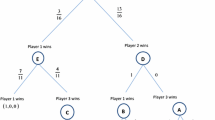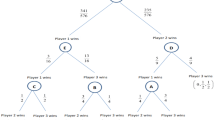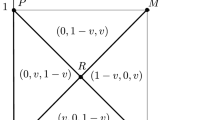Abstract
We propose a novel tournament design that incorporates some properties of a round-robin tournament, a Swiss tournament, and a race. The new design includes an all-play-all structure with endogenous scheduling and a winning threshold. Considering a standard round-robin tournament as a baseline model, we first characterize the equilibrium strategies in round-robin tournaments with exogenous and endogenous schedules. Afterward, following an equilibrium analysis of the new tournament design, we compare thirty-six tournament structures inherent in our model with round-robin tournaments on the basis of expected equilibrium effort per battle. We show that a round-robin tournament with an endogenous schedule outperforms all the other tournament structures considered here. We further note that if expected total equilibrium effort is used as a comparison criterion instead, then the new tournament design has a potential to improve upon round-robin tournaments.


Similar content being viewed by others
Notes
A detailed explanation about the number of tournament structures is provided in Sect. 3.
The latter is a direct consequence of introducing a victory threshold into a standard round-robin tournament.
The maximization of expected total equilibrium effort is, arguably, the most frequently-used objective criterion in contest theory. It is especially relevant in sport contests where higher total effort is related to higher attendance and greater revenue. A second rationale for total effort maximization is related to fairness: when higher efforts are exerted in component battles, one would expect an improvement in the tournament’s ability to reveal the best team. See Dasgupta and Nti (1998), Moldovanu and Sela (2001), Borland and MacDonald (2003), Szymanski (2003), Nti (2004) among others. On the other hand, since the expected number of battles is not the same among all tournament models considered here, it can be argued that the maximization of expected equilibrium effort per battle is a more suitable objective criterion for the current paper.
We are also aware of a recent working paper, by Sela et al. (2020), which analyzes a round-robin tournament with four symmetric players and two prizes.
This assumption helps us to avoid the nonexistence of a best response for a non-discouraged player against a totally discouraged player. It does not make a significant impact on our results. An alternative assumption is to assume that each player’s strategy set in a battle is \(\{0\} \cup [\varepsilon , \infty )\) rather than \([0,\infty )\), so that for a sufficiently small \(\varepsilon > 0\), a non-discouraged player puts \(\varepsilon\) amount of effort as a response to zero effort, which in turn implies that the player wins for sure (see Sahm 2019).
For risk-neutral players, this is equivalent to assuming that the winning prize is randomly awarded to one of those players with equal probabilities.
Notice that such a round-robin tournament with an endogenously-determined schedule is a natural combination of a round-robin tournament and a Swiss tournament.
In the following, by an abuse of notation, we omit the current round or state when denoting players’ effort choices. Moreover, in all utility maximization problems considered below, the respective second-order conditions hold.
We thank an anonymous reviewer for bringing this to our attention.
The “per battle” adjustment we make here is similar to the one in Laica et al. (2017), who used aggregate effort per unit of prize money per match as a measure of intensity to correct for the differing number of matches while comparing tournaments with different number of players.
Compared to a round-robin tournament, this specification tries to break the tie after the first three rounds, but if tie is not broken, there will be two co-champions.
It is worth reminding here that in any version of round-robin tournaments considered in Sect. 2, all two-victory players become co-champions.
The online supplementary file is available on the corresponding author’s web page, https://sites.google.com/site/eminkaragozoglu/home/research.
This is because the player with no victory is totally discouraged on node (2,1,1,0) in equilibrium.
This is the only reachable node that leads to a final game.
References
Borland J, MacDonald R (2003) Demand for sport. Oxf Rev Econ Policy 19:478–502
Dagaev D, Zubanov A (2017) Round-robin tournaments with limited resources. Higher School of Economics Research Paper, WP BRP 171/EC/2017
Dasgupta A, Nti KO (1998) Designing an optimal contest. Eur J Polit Econ 14:587–603
Doğan S, Karagözoğlu E, Keskin K, Sağlam Ç (2018) Multi-player race. J Econ Behav Organ 149:123–136
Fleurent C, Ferland JA (1993) Allocating games for the NHL using integer programming. Oper Res 41:649–654
Harbaugh R, Klumpp T (2005) Early round upsets and championship blowouts. Econ Inq 43:316–329
Henz M, Muller T, Thiel S (2004) Global constraints for round robin tournaments scheduling. Eur J Oper Res 153:92–101
Klumpp T, Polborn MK (2006) Primaries and the New Hampshire effect. J Public Econ 90:1073–1114
Konrad K, Kovenock D (2009) Multi-battle contests. Games Econ Behav 66:256–274
Krumer A, Megidish R, Sela A (2017a) First-mover advantage in round-robin tournaments. Soc Choice Welf 48:633–658
Krumer A, Megidish R, Sela A (2017b) Round-robin tournaments with a dominant player. Scand J Econ 119:1167–1200
Krumer A, Megidish R, Sela A (2020) The optimal design of round-robin tournaments with three players. J Sched 23:379–396
Laica C, Lauber A, Sahm M (2017) Sequential round-robin tournaments with multiple prizes. CESifo Working Paper No 6685
Laica C, Lauber A, Sahm M (2021) Sequential round-robin tournaments with multiple prizes. Games Econ Behav 129:421–448
Lazear EP, Rosen S (1981) Rank-order tournaments as optimum labor contracts. J Polit Econ 89:841–864
Moldovanu B, Sela A (2001) The optimal allocation of prizes in contests. Am Econ Rev 91:542–558
Nemhauser GL, Trick MA (1998) Scheduling a major college basketball conference. Oper Res 46:1–8
Nti KO (2004) Maximum efforts in contests with asymmetric valuations. Eur J Polit Econ 20:1059–1066
Prendergast C (1999) The provision of incentives in firms. J Econ Lit 37:7–63
Rasmussen RV, Trick MA (2008) Round robin scheduling—a survey. Eur J Oper Res 188:617–636
Rosen S (1986) Prizes and incentives in elimination tournaments. Am Econ Rev 76:701–715
Russel RA, Leung JMY (1994) Devising a cost effective schedule for a baseball league. Oper Res 42:614–625
Sahm M (2019) Are sequential round-robin tournaments discriminatory? J Public Econ Theory 21:44–61
Sela A, Krumer A, Megidish R (2020) Strategic manipulations in round-robin tournaments. CEPR Discussion Paper No. DP14412
Szymanski S (2003) The economic design of sporting contests. J Econ Lit 41:1137–1187
Acknowledgements
We would like to thank the associate editor and two anonymous reviewers for their constructive comments and suggestions. Furthermore, Emin Karagözoğlu and Çağrı Sağlam thank The Scientific and Technological Research Council of Turkey (TÜBITAK) for financial support under grant number 118K239. The usual disclaimers apply.
Author information
Authors and Affiliations
Corresponding author
Additional information
Publisher's Note
Springer Nature remains neutral with regard to jurisdictional claims in published maps and institutional affiliations.
Rights and permissions
About this article
Cite this article
Çağlayan, D., Karagözoğlu, E., Keskin, K. et al. Effort comparisons for a class of four-player tournaments. Soc Choice Welf 59, 119–137 (2022). https://doi.org/10.1007/s00355-021-01381-4
Received:
Accepted:
Published:
Issue Date:
DOI: https://doi.org/10.1007/s00355-021-01381-4




